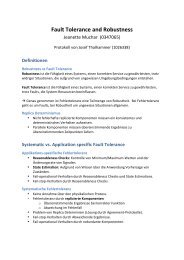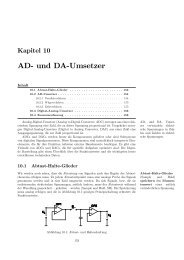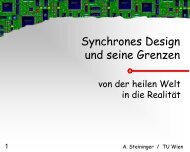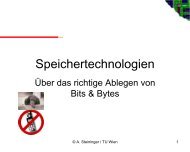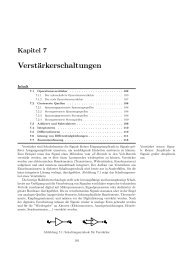Introduction to Microcontrollers
Introduction to Microcontrollers
Introduction to Microcontrollers
Create successful ePaper yourself
Turn your PDF publications into a flip-book with our unique Google optimized e-Paper software.
1.3. NOTATION 7<br />
operated stand-alone, at the very least it requires some memory and an output device <strong>to</strong> be<br />
useful.<br />
Please note that a processor is no controller. Nevertheless, some manufacturers and vendors list<br />
their controllers under the term “microprocessor”. In this text we use the term processor just<br />
for the processor core (the CPU) of a microcontroller.<br />
Microcontroller: A microcontroller already contains all components which allow it <strong>to</strong> operate standalone,<br />
and it has been designed in particular for moni<strong>to</strong>ring and/or control tasks. In consequence,<br />
in addition <strong>to</strong> the processor it includes memory, various interface controllers, one or<br />
more timers, an interrupt controller, and last but definitely not least general purpose I/O pins<br />
which allow it <strong>to</strong> directly interface <strong>to</strong> its environment. <strong>Microcontrollers</strong> also include bit operations<br />
which allow you <strong>to</strong> change one bit within a byte without <strong>to</strong>uching the other bits.<br />
Mixed-Signal Controller: This is a microcontroller which can process both digital and analog signals.<br />
Embedded System: A major application area for microcontrollers are embedded systems. In embedded<br />
systems, the control unit is integrated in<strong>to</strong> the system 3 . As an example, think of a cell<br />
phone, where the controller is included in the device. This is easily recognizable as an embedded<br />
system. On the other hand, if you use a normal PC in a fac<strong>to</strong>ry <strong>to</strong> control an assembly<br />
line, this also meets many of the definitions of an embedded system. The same PC, however,<br />
equipped with a normal operating system and used by the night guard <strong>to</strong> kill time is certainly<br />
no embedded system.<br />
Real-Time System: Controllers are frequently used in real-time systems, where the reaction <strong>to</strong> an<br />
event has <strong>to</strong> occur within a specified time. This is true for many applications in aerospace,<br />
railroad, or au<strong>to</strong>motive areas, e.g., for brake-by-wire in cars.<br />
Embedded Processor: This term often occurs in association with embedded systems, and the differences<br />
<strong>to</strong> controllers are often very blurred. In general, the term “embedded processor” is used<br />
for high-end devices (32 bits), whereas “controller” is traditionally used for low-end devices (4,<br />
8, 16 bits). Mo<strong>to</strong>rola for example files its 32 bit controllers under the term “32-bit embedded<br />
processors”.<br />
Digital Signal Processor (DSP): Signal processors are used for applications that need <strong>to</strong> —no surprise<br />
here— process signals. An important area of use are telecommunications, so your mobile<br />
phone will probably contain a DSP. Such processors are designed for fast addition and multiplication,<br />
which are the key operations for signal processing. Since tasks which call for a signal<br />
processor may also include control functions, many vendors offer hybrid solutions which combine<br />
a controller with a DSP on one chip, like Mo<strong>to</strong>rola’s DSP56800.<br />
1.3 Notation<br />
There are some notational conventions we will follow throughout the text. Most notations will be<br />
explained anyway when they are first used, but here is a short overview:<br />
3 The exact definition of what constitutes an embedded system is a matter of some dispute. Here is an example<br />
definition of an online-encyclopaedia [Wik]:<br />
An embedded system is a special-purpose computer system built in<strong>to</strong> a larger device. An embedded system<br />
is typically required <strong>to</strong> meet very different requirements than a general-purpose personal computer.<br />
Other definitions allow the computer <strong>to</strong> be separate from the controlled device. All definitions have in common that the<br />
computer/controller is designed and used for a special-purpose and cannot be used for general purpose tasks.



